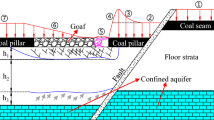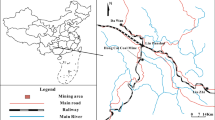Abstract
Due to the high pressure of confined water in deep mines, the incidence of water inrush disasters in China caused by geological structures, especially faults, are becoming more frequent and more complicated. Using the Comsol numerical simulation software, we analyzed the formation and evolution of a water inrush channel in the floor of a deep mine with buried faults. The numerical model was set up using geological data from an actual coal mine that is highly threatened by confined water with buried faults. The results show that the stress became more and more concentrated near the buried fault as the working face advanced. The flow velocity inside the fault was much greater than in the floor, which means that the buried structure was important in the ascension of the confined water and destruction of the floor. A water inrush channel formed when the failure zone connected with the fissures of the buried fault.
Zusammenfassung
Aufgrund hohen Druckes gespannter Wässer treten in chinesischen Tiefbaugruben katastrophale Wassereinbrüche, ausgelöst durch geologische Strukturen, insbesondere Störungen, zunehmend häufiger und in komplexerer Form auf. Unter Verwendung der numerischen Simulations-Software Comsol wurde im Rahmen der Arbeit die Entstehung und Entwicklung eines Wassereinbruchskanals in einer durch verdeckte Störungen charakterisierten Sohle einer Tiefbaugrube untersucht. Das numerische Modell wurde unter Nutzung geologischer Daten eines existierenden, durch gespannte Wässer und verdeckte Störungen stark gefährdeten Kohlenbergwerks erstellt. Die Ergebnisse belegen eine mit fortschreitendem Verhieb stärker werdende Konzentration der Spannungen im Bereich der verdeckten Störung. Die Fließgeschwindigkeit innerhalb der Störung war sehr viel größer als innerhalb der Sohle, so dass die verdeckte Struktur für das Aufsteigen der gespannten Wässer und die Zerstörung der Sohle bedeutsam war. Ein Wassereinbruchskanal bildete sich in dem Moment, in dem sich die Bruchzone mit den Spalten der verdeckten Störungszone verband. Translator: Michael Paul
Resumen
Debido a la alta presión del agua confinada en las minas profundas, la incidencia de los desastres de irrupción de agua en China causados por las estructuras geológicas, especialmente por las fallas, son cada vez más frecuentes y complicadas. Usando el software de simulación numérica Comsol, analizamos la formación y evolución de un canal de irrupción de agua en el suelo de una mina profunda con fallas enterradas. El modelo numérico se estableció utilizando datos geológicos de una mina de carbón real que está altamente amenazada por agua confinada con fallas enterradas. Los resultados muestran que el estrés se concentró cada vez más cerca de la falla enterrada a medida que avanzaba la cara de trabajo. La velocidad de flujo dentro de la falla fue mucho mayor que en el piso lo que significa que la estructura enterrada fue importante en el ascenso del agua confinada y la destrucción del piso. Se formó un canal de irrupción de agua cuando la zona de falla se conectó con las fisuras de la falla enterrada.
Resumen
由于大采深矿井承压含水层水压大,地质构造特别是断层引起的突水灾害发生越来越频繁和复杂。利用COMSOL数值模拟软件,分析了大采深矿井底板含断层时突水通道的形成和演变过程。利用受底板高承压水威胁的实际矿井的地质资料建立了数学模型。 结果表明,随着工作面推进,应力越来越集中隐伏断层附近。断层带内地下水流速远大于底板,意味着地下隐伏构造对承压水上升和底板破坏具有重要作用。断层破碎带与隐伏断层裂隙连通时形成突水通道。







Similar content being viewed by others
References
Bereslavskii EN (2011) Simulation of seepage flows from channels. PMM-J Appl Math Mec 75(4):398–403
Bukowski P (2011) Water hazard assessment in active shafts in upper Silesian coal basin mines. Mine Water Environ 30(4):302–311
Dumpleton S, Robins NS, Walker JA, Merrin PD (2001) Mine water rebound in south Nottinghamshire: risk evaluation using 3-D visualization and predictive modeling. Q J Eng Geol Hydrogeol 34(3):307–319
Feng LQ, Wang WJ, Zhu CQ, Peng WQ (2009) Analysis of fault water-inrush mechanism based on the principle of water-resistant key strata. J Min Saf Eng 26(1):87–90 (in Chinese)
Grasemann B, Exner U, Tschegg C (2011) Displacement–length scaling of brittle faults in ductile shear. J Struct Geol 33(11):1650
Hodlur G, Prakash RM, Deshmukh S, Singh V (2002) Role of some salient geo-physical, geochemical, and hydrogeological parameters in the exploration of fresh groundwater in a brackish terrain. Environ Geol 41(7):861–866
Li LP, Zhou ZQ, Li SC, Xue YG, Xu ZH, Shi SS (2015) An attribute synthetic evaluation system for risk assessment of floor water inrush in coal mines. Mine Water Environ 34:288–294
Li WP, Liu Y, Qiao W, Zhao C, Yang DD, Guo QC (2018) An improved vulnerability assessment model for floor water bursting from a confined aquifer based on the water inrush coefficient method. Mine Water Environ 37(1):196–204
Lu Y, Wang L (2015) Numerical simulation of mining-induced fracture evolution and water flow in coal seam floor above a confined aquifer. Comput Geotech 67:157–171
Odintsev VN, Miletenko NA (2015) Water inrush in mines as a consequence of spontaneous hydrofracture. J Min Sci 51(3):423–434
Shao J, Zhou F, Sun W (2019) Evolution model of seepage characteristics in the process of water inrush in faults. Geofluids 2019:1–14
Sun WB, Xue YC (2018) An improved fuzzy comprehensive evaluation system and application for risk assessment of floor water inrush in deep mining. Geotech Geol Eng. https://doi.org/10.1007/s10706-018-0673-x
Sun WB, Du HQ, Zhou F, Shao JL (2019) Experimental study of crack propagation of rock-like specimens containing conjugate fractures. Geomech Eng 17(4):323–331. https://doi.org/10.12989/gae.2019.17.4.323
Wang Y, Yang WF, Li M, Liu X (2012) Risk assessment of floor water inrush in coal mines based on secondary fuzzy comprehensive evaluation. Int J Rock Mech Min 52(6):50–55
Wang T, Wang ZH, Jiang YD, Wang WJ (2014) Experimental study on stress distribution and evolution surrounding rock under the influence of fault slip induced by mining. J China Univ Min Technol 43:588–592 (in Chinese)
Wang G, Li W, Wang P, Yang X, Zhang S (2017) Deformation and gas flow characteristics of coal-like materials under triaxial stress conditions. Int J Rock Mech Min 91:72–80
Wu Q, Liu YZ, Wu HX, Zeng YF (2017) Assessment of floor water inrush with vulnerability index method: application in Malan coal mine of Shanxi Province, China. Q J Eng Geol Hydrogeol 50(2):169–178
Xiong ZQ, Wang XL (2014) Similar simulation for breakage law and cracks evolution of working face in coal mining above aquifer. Chin J Undergr Space Eng 10(05):1114–1120 (in Chinese)
Yin DW, Chen SJ, Liu XQ, Ma HF (2018a) Effect of joint angle in coal on failure mechanical behavior of roof rock-coal combined body. Q J Eng Geol Hydrogeol 51:202–209
Yin DW, Chen SJ, Liu XQ, Ma HF (2018b) Simulation study on strength and failure characteristics for granite with a set of cross-joints of different lengths. Adv Civ Eng 2018:1–10
Zhang WQ (2004) Study on the mechanism of water-bursting from the floor of mine and its integrated judgment and measure and the software exploitation of forecast system. Ph.D. Dissertation, Shandong University of Science and Technology (in Chinese)
Zhang SC, Guo WJ, Li YY, Sun WB, Yin DW (2017) Experimental simulation of fault water inrush channel evolution in a coal mine floor. Mine Water Environ 36:443–451
Zhang SC, Li YY, Shen BT, Sun XZ, Gao LQ (2018) Effective evaluation of pressure relief drilling for reducing rock bursts and its application in underground coal mines. Int J Rock Mech Min 114:7–16. https://doi.org/10.1016/j.ijrmms.2018.12.010
Zhou QL, Herrera J, Hidalgo A (2018) The numerical analysis of fault-induced mine water inrush using the extended finite element method and fracture mechanics. Mine Water Environ 37:185–195
Acknowledgements
This research was financially supported by the National Natural Science Foundation of China (51404146), China Postdoctoral Science Foundation (2015M572067), Postdoctoral Innovation Project of Shandong Province (152799), Key R & D Projects in Shandong Province (2015GSF120016), Qingdao Postdoctoral Applied Research Project (2015203), Young Teachers’ Growth Program of Shandong Province, Natural Science Foundation of Shandong Province (ZR2019MEE004) and the Shandong University of Science and Technology (SDUST) Research Fund (2018TDJH102).
Author information
Authors and Affiliations
Corresponding author
Rights and permissions
About this article
Cite this article
Sun, W., Xue, Y., Li, T. et al. Multi-field Coupling of Water Inrush Channel Formation in a Deep Mine with a Buried Fault. Mine Water Environ 38, 528–535 (2019). https://doi.org/10.1007/s10230-019-00616-2
Received:
Accepted:
Published:
Issue Date:
DOI: https://doi.org/10.1007/s10230-019-00616-2




